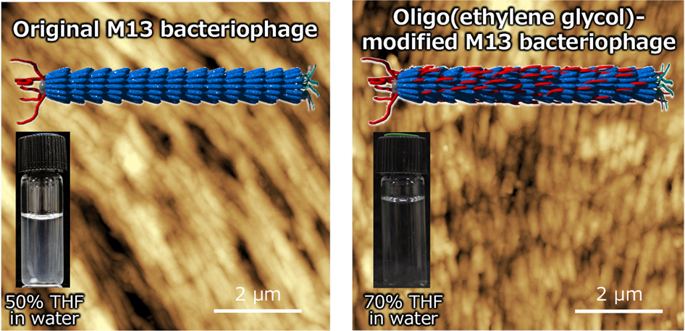Our official English website, www.x-mol.net, welcomes your
feedback! (Note: you will need to create a separate account there.)
Thermally conductive molecular assembly composed of an oligo(ethylene glycol)-modified filamentous virus with improved solubility and resistance to organic solvents
Polymer Journal ( IF 2.3 ) Pub Date : 2020-03-26 , DOI: 10.1038/s41428-020-0328-7 Toshiki Sawada , Taiki Tsuruoka , Naoki Ueda , Hironori Marubayashi , Shuichi Nojima , Junko Morikawa , Takeshi Serizawa
Polymer Journal ( IF 2.3 ) Pub Date : 2020-03-26 , DOI: 10.1038/s41428-020-0328-7 Toshiki Sawada , Taiki Tsuruoka , Naoki Ueda , Hironori Marubayashi , Shuichi Nojima , Junko Morikawa , Takeshi Serizawa

|
Organic polymers are generally regarded as thermal insulators because of their random arrangement of polymeric chains that lead to scattering of heat-conducting phonons. We previously found that highly oriented assemblies composed of M13 phage, a filamentous virus, showed high thermal diffusivity, even though phonons are conducted on noncovalent bonds. However, biomolecular M13 phages did not allow utilization of organic solvents, resulting in limited applicability. Here, we utilized chemically modified M13 phage with oligo(ethylene glycol) (OEG) to improve its solubility and resistance to organic solvents, and to expand the applicability of phage-based thermally conductive assemblies. The high thermal diffusivity of assemblies composed of M13 phages modified with longer EG chains (EG unit: 10) was maintained when the assemblies were prepared using a mixed solvent of water and tetrahydrofuran, whereas that of assemblies composed of unmodified and shorter EG chain (3 and 6)-modified M13 phages was not maintained. When the mixed solvent was used, structural characterization revealed the presence of ordered and hexagonally packed structures that formed ordered assemblies, leading to phonon-conductive assemblies in the case of the longer EG chain-modified M13 phages. Our results will contribute to the construction of novel thermally conductive soft materials composed of biomacromolecular assemblies using organic solvents on substrates with complex surface morphologies and/or hydrophobic surfaces. Utilization of chemical modification of M13 phage with oligo(ethylene glycol) to improve its solubility and resistance to organic solvents successfully expands the applicability of M13 phage-based thermally conductive assemblies. The high thermal diffusivity of the assemblies composed of M13 phage modified with longer ethylene glycol chains was maintained when the assemblies were prepared using a mixed solvent of water and tetrahydrofuran. Our results will contribute to construction of novel thermally conductive soft materials composed of biomacromolecular assemblies using organic solvents on substrates with complex surface morphologies and/or hydrophobic surfaces.
中文翻译:

由低聚(乙二醇)修饰的丝状病毒组成的导热分子组装体,具有改善的溶解性和对有机溶剂的耐受性
有机聚合物通常被认为是热绝缘体,因为它们的聚合物链的随机排列会导致导热声子的散射。我们之前发现,由 M13 噬菌体(一种丝状病毒)组成的高度定向的组件显示出高热扩散性,即使声子是在非共价键上进行的。然而,生物分子 M13 噬菌体不允许利用有机溶剂,导致适用性有限。在这里,我们利用化学修饰的 M13 噬菌体和低聚(乙二醇)(OEG)来提高其溶解性和对有机溶剂的耐受性,并扩大基于噬菌体的导热组件的适用性。由用更长 EG 链修饰的 M13 噬菌体组成的组件的高热扩散率(EG 单元:当使用水和四氢呋喃的混合溶剂制备组件时,保留了 10),而由未修饰和较短 EG 链(3 和 6)修饰的 M13 噬菌体组成的组件不保留。当使用混合溶剂时,结构表征显示存在形成有序组装的有序和六边形堆积结构,在较长的 EG 链修饰的 M13 噬菌体的情况下导致声子导电组装。我们的研究结果将有助于在具有复杂表面形态和/或疏水表面的基材上使用有机溶剂构建由生物大分子组装体组成的新型导热软材料。利用低聚(乙二醇)对 M13 噬菌体进行化学修饰以提高其溶解性和对有机溶剂的耐受性,成功扩展了基于 M13 噬菌体的导热组件的适用性。当使用水和四氢呋喃的混合溶剂制备组装体时,由用较长乙二醇链修饰的 M13 噬菌体组成的组装体的高热扩散率得以保持。我们的研究结果将有助于在具有复杂表面形态和/或疏水表面的基材上使用有机溶剂构建由生物大分子组装体组成的新型导热软材料。当使用水和四氢呋喃的混合溶剂制备组装体时,由用较长乙二醇链修饰的 M13 噬菌体组成的组装体的高热扩散率得以保持。我们的研究结果将有助于在具有复杂表面形态和/或疏水表面的基材上使用有机溶剂构建由生物大分子组装体组成的新型导热软材料。当使用水和四氢呋喃的混合溶剂制备组装体时,由用较长乙二醇链修饰的 M13 噬菌体组成的组装体的高热扩散率得以保持。我们的研究结果将有助于在具有复杂表面形态和/或疏水表面的基材上使用有机溶剂构建由生物大分子组装体组成的新型导热软材料。
更新日期:2020-03-26
中文翻译:

由低聚(乙二醇)修饰的丝状病毒组成的导热分子组装体,具有改善的溶解性和对有机溶剂的耐受性
有机聚合物通常被认为是热绝缘体,因为它们的聚合物链的随机排列会导致导热声子的散射。我们之前发现,由 M13 噬菌体(一种丝状病毒)组成的高度定向的组件显示出高热扩散性,即使声子是在非共价键上进行的。然而,生物分子 M13 噬菌体不允许利用有机溶剂,导致适用性有限。在这里,我们利用化学修饰的 M13 噬菌体和低聚(乙二醇)(OEG)来提高其溶解性和对有机溶剂的耐受性,并扩大基于噬菌体的导热组件的适用性。由用更长 EG 链修饰的 M13 噬菌体组成的组件的高热扩散率(EG 单元:当使用水和四氢呋喃的混合溶剂制备组件时,保留了 10),而由未修饰和较短 EG 链(3 和 6)修饰的 M13 噬菌体组成的组件不保留。当使用混合溶剂时,结构表征显示存在形成有序组装的有序和六边形堆积结构,在较长的 EG 链修饰的 M13 噬菌体的情况下导致声子导电组装。我们的研究结果将有助于在具有复杂表面形态和/或疏水表面的基材上使用有机溶剂构建由生物大分子组装体组成的新型导热软材料。利用低聚(乙二醇)对 M13 噬菌体进行化学修饰以提高其溶解性和对有机溶剂的耐受性,成功扩展了基于 M13 噬菌体的导热组件的适用性。当使用水和四氢呋喃的混合溶剂制备组装体时,由用较长乙二醇链修饰的 M13 噬菌体组成的组装体的高热扩散率得以保持。我们的研究结果将有助于在具有复杂表面形态和/或疏水表面的基材上使用有机溶剂构建由生物大分子组装体组成的新型导热软材料。当使用水和四氢呋喃的混合溶剂制备组装体时,由用较长乙二醇链修饰的 M13 噬菌体组成的组装体的高热扩散率得以保持。我们的研究结果将有助于在具有复杂表面形态和/或疏水表面的基材上使用有机溶剂构建由生物大分子组装体组成的新型导热软材料。当使用水和四氢呋喃的混合溶剂制备组装体时,由用较长乙二醇链修饰的 M13 噬菌体组成的组装体的高热扩散率得以保持。我们的研究结果将有助于在具有复杂表面形态和/或疏水表面的基材上使用有机溶剂构建由生物大分子组装体组成的新型导热软材料。











































 京公网安备 11010802027423号
京公网安备 11010802027423号